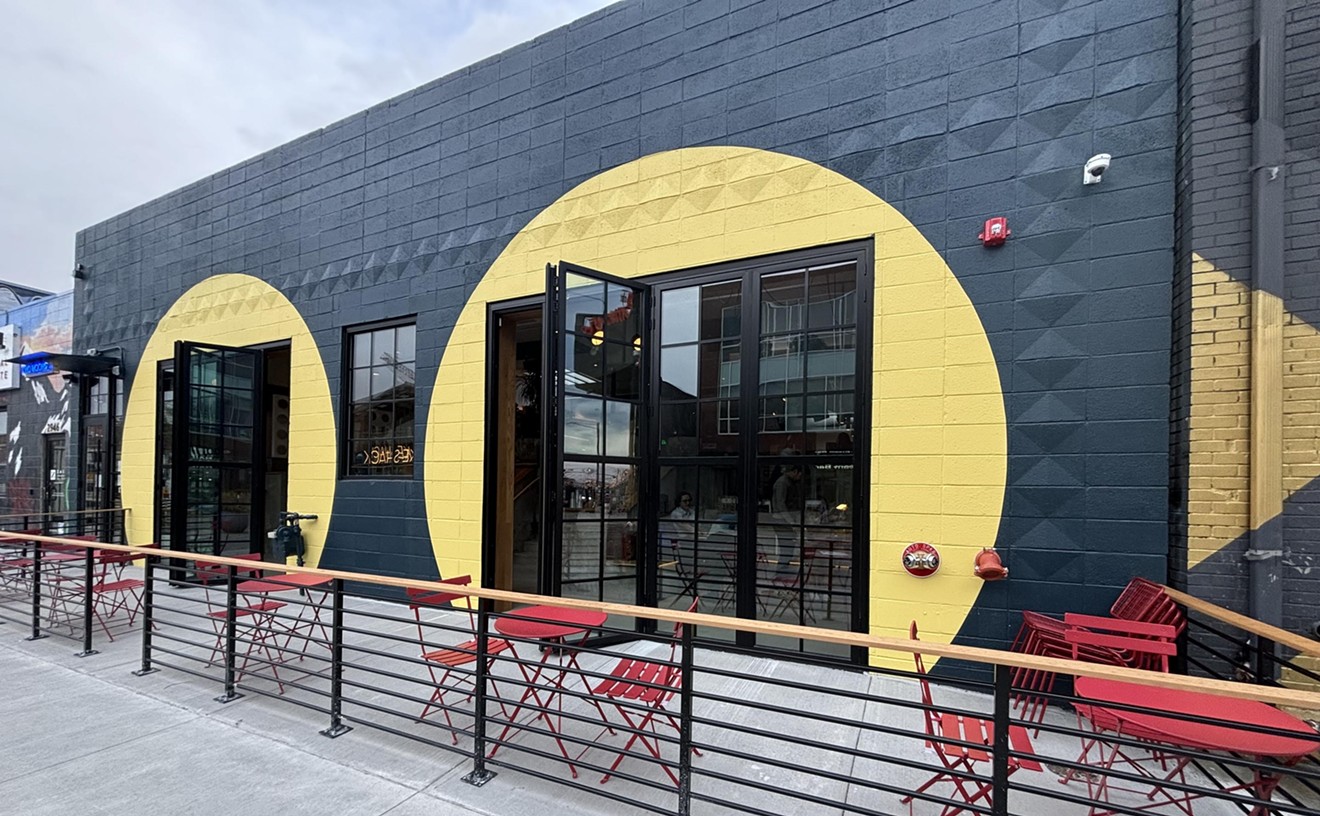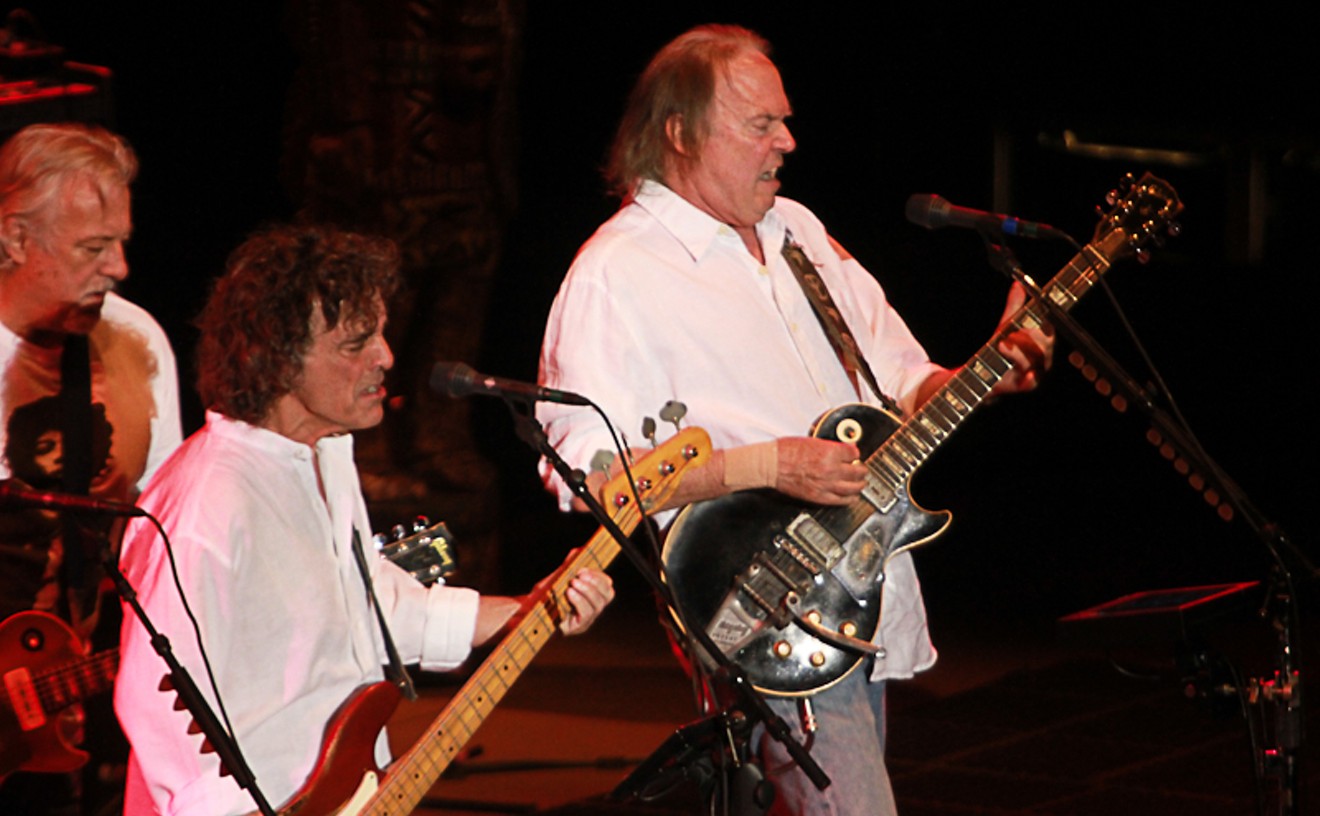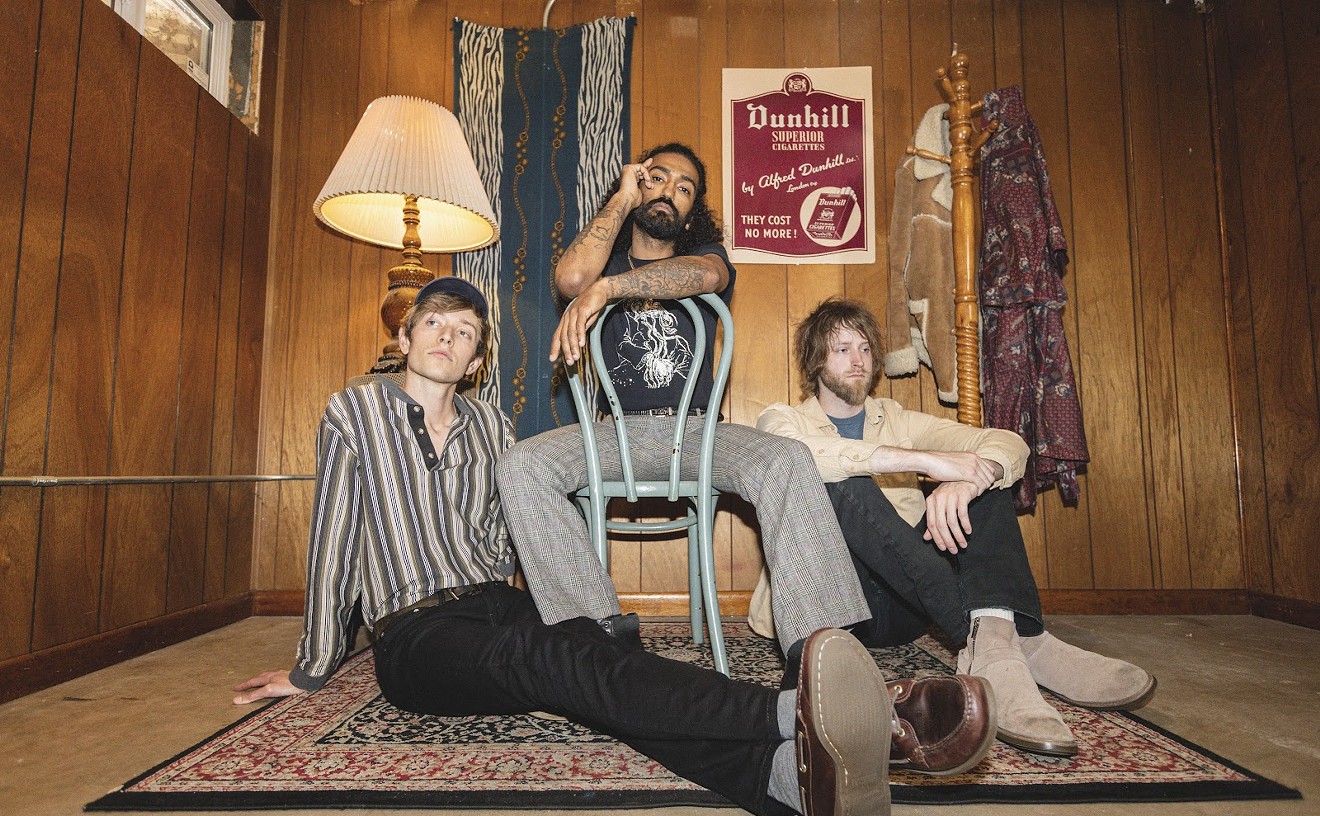Now: The Who's last major tour took place in 1982, following the release of the mistitled platter It's Hard. Because it was advertised as a farewell trek and carried a high-profile sponsorship from Schlitz beer, perhaps the most repulsive beverage ever concocted, critics called foul--and they were right to do so. Such greedy behavior would have been expected from most pop outfits, but not from the Who, a unit renowned for its insistence on integrity and artistic credibility. This unparalleled money grab sullied the reputation of the participants, sending a great band out on a sour note.
Given the sense of distrust the excursion engendered, it was no surprise when Town-shend, Daltrey and Entwistle reunited earlier this year for a performance of material from the 1973 Who album Quadrophenia that was taped for cable television. Nor were observers startled when the threesome decided to take the show on the road. What was unanticipated, though, were the soft sales for the October 29 McNichols Arena stopover, underwritten by local radio outlet KKHK-FM/99.5 (the Hawk). Despite a constant stream of hype from the station and a raft of television ads, the date was notably short of a sellout. If you had a spare $70 or so lying around, you could have purchased a seat the night of the show. No sleeping on floors required.
Then: I don't have a vivid memory of what my buddies and I did prior to the 1979 concert--which undoubtedly means we were drinking. This was near the end of my hard-liquor period, so I imagine we conned some older delinquent into purchasing for us bottles of Seagram's and Cutty Sark whiskey that we later mixed inside half-drained cans of 7-Up or Coke. (That way, it tasted great going down and coming back up.) I remember the crowd as roughly split between youngsters of my vintage and folks between their mid-twenties and mid-thirties. Most of those in the latter category were rock veterans, with yards of flowing hair and Who, Zeppelin or Sabbath T-shirts stretched across their burly frames. They could have crushed me like a cricket had they been so inclined.
Now: The young people at this year's concert were really young--mostly elementary-schoolers on a night out with Dad. Otherwise, the crowd was overwhelmingly male, overwhelmingly middle-aged, overwhelmingly white-collar and (yes) overwhelmingly white. As befits this demographic, my wife and I overheard several different clusters of people discussing the city's finest restaurants. Later, a guy behind me mentioned Pantera--and thinking he was talking about the extremely abrasive band of the same name, my ears perked up. I soon discovered, however, that he was discussing a make of sports car. He subsequently noted his fondness for Jethro Tull while describing a woman of his acquaintance as "thick as a brick."
Then: I'll bet there was an opening act on the 1979 bill, but I don't recall it. Must've sucked.
Now: A conglomeration called the Hypocrites went on before the Who this time around. By next week, I won't remember a thing about them other than that they definitely sucked. A month down the line, even that observation will have slipped my mind.
Then: The obstructed-view seats, located on the right side of the arena, didn't turn out to be too bad; the only person we couldn't see well (due to a hanging speaker) was keyboardist Bundrick--hardly the most scintillating visual presence in the room. Jones wasn't much to look at, either: A workmanlike timekeeper, he did his job efficiently and without much fuss. But the rest of the musicians, who hit the stage with a thrillingly deafening crash, more than made up for these deficiencies. Entwistle didn't appear to be doing much, but his presence was magnetic nonetheless. His bass lines were prominent, fluid, elastic and thoroughly impressive. As for Daltrey, he looked every inch the Dionysian music god, thanks to his tumbling locks, broad chest and impossibly tight trousers. His throaty roar of a voice easily trebled the considerable ferocity it displayed on vinyl, and his skill at twirling microphones was positively astounding. At times, he let out so much of the mike's chord that the device came within inches of his fellow musicians. The suspense, as a result, was terrific. Townshend, meanwhile, seemed every bit as feverish and aggressive as he'd appeared in the films I'd seen of his Sixties and early-Seventies performances. If time had taken a toll on his wild guitar chording, spontaneous vocalizing and general sense of intensity, I didn't perceive it.
Now: Hooray--my seat allowed me to see Rabbit Bundrick (as forgettable-looking a fellow as any who have trod the earth). Also before me were three video screens, a five-piece horn section, a percussionist surrounded by various gongs and chimes, a synthesist, singer-guitarist Simon "Younger Brother of Pete" Townshend and drummer Zak Starkey, who resembles Ewan McGregor, the star of Trainspotting, far more than he does his famous father (Ringo Starr). Townshend, for his part, didn't even resemble himself: With his receding hairline, hangdog expression and ill-fitting suit, he could have passed for a temporary worker at H&R Block. Entwistle cut a slightly more interesting figure (with his red jacket and white beard, he looked like a somewhat dour Father Christmas), but in reality, only Daltrey seemed to have aged well. The way his jeans and workshirt fit implied that he's been spending his free time (of which he's had plenty) on Nautilus equipment--and this impression was only amplified when he stripped down to a muscle T-shirt. At the sight of his rippling musculature, three women behind me gasped in unison, "Oh, my God!"
It was impossible to know if Daltrey's voice was in the same kind of shape: From where I was sitting, his singing was consistently buried in the instrumentation, as was Entwistle's bass playing. Worse, the guitar playing of the elder Townshend, who stuck to an acoustic for most of the set, was mainly a musical non-factor--and Simon's standard-issue leads didn't make up for this absence. Twenty-three years ago, when Quadrophenia initially hit the streets, the notion of a Who concert in which guitars hardly mattered would have been absurd, but not today. That's progress, I guess.
Then: One day in 1985, six years after the Who show, I was working at a Tower Records branch located on Los Angeles's Sunset Strip when Billy Idol walked in the door. Tower types knew he was in town--we'd heard that this then-famous personage was holed up in a nearby West Hollywood hotel and was shagging all comers. (The grapevine also reported that a particularly friendly clerk at the store had given Billy a knob job in the Tower employee restroom--a claim that was unsubstantiated but easy to believe.) As the singer moved toward the rear of the store, I mentioned to a fellow staffer, a hazy-eyed, hey-dude type named Todd, that I found Idol to be among the more worthless and ludicrous figures on the pop-music scene. Todd nodded and disappeared, returning moments later with Idol in tow. "Billy, this is Mike," he said. "He's one of your biggest fans, and he really wanted to meet you, but he was just too shy to ask." Idol grinned pleasantly and extended his hand--and when I shook it, I discovered that it was damp. No, not just damp: It was oily, greasy, covered with a kind of viscous, possibly disease-carrying film that immediately attached itself to my skin and refused to let go. As soon as I could, I scurried to the employee restroom--yes, that restroom--and began vigorously washing my mitt. Weeks passed before it felt clean again.
Now: Unexpectedly, I thoroughly enjoyed seeing Idol, one of the Quadrophenia tour's special guests, for the first time since that long-ago day. Clad in a shiny suit and sneering for all he was worth, he was obviously overjoyed to be in the spotlight before so many people. Whereas Daltrey was content to pose (and Entwistle and Townshend often seemed to disappear into the wallpaper), Idol actually seemed eager to put on a show. To look at him was to laugh, but that didn't bother Billy. For him, being seen was enough--and if that meant putting on bellboy duds later in the show and doing some of the worst acting this side of Doctor Quinn, Medicine Woman, so be it. Gary Glitter, who was hauled out to warble "The Punk and the Godfather," exhibited a similar enthusiasm, but the sight of him was, quite frankly, disturbing. He looked like a cross between Louie Anderson and Divine--with a little Rip Taylor sprinkled on top for good measure.
Then: No particular theme dominated the Who's 1979 turn. The band played material from a variety of albums and periods--lots of Who's Next, of course, but also early hits (I seem to recollect "I Can See for Miles" and "Summertime Blues") and some tunes I didn't recognize; in all likelihood, they wound up on Face Dances, the Who disc released the following year. What held this disparate fodder together was passion. With Moon on a slab, the Who survivors had something to prove, and they went out of their way to do it. People prepared to write them off were forced to reconsider their preconceptions. There appeared to be a lot of life in the old band yet.
Now: On the surface, playing a full version of Quadrophenia was as good an excuse for a Who comeback tour as any. Although this so-called rock opera wasn't any great shakes in the dramatic department (it was built around a rather familiar coming-of-age story line), it contained plenty of good songs--including "The Real Me," "I'm One" and "Love, Reign O'er Me"--that haven't been pounded into the ground by classic-rock radio to the degree that the cuts on the aforementioned Who's Next have. It also had a theatrical shape that could be presented as an "event" to the folks who hadn't caught the stage version of Tommy on Broadway. History also lent a hand: Because the band's attempt to perform Quadrophenia at the time of its original release was a legendary catastrophe (due mainly to the difficulty of synchronizing live music with tapes of background parts), publicists could portray the jaunt not as an opportunity to fatten wallets, but as a chance for Townshend to present the work as he'd always dreamed.
Unfortunately, the passage of more than two decades has made the bandmembers singularly inappropriate to act out the piece. While the central character, Jimmy, was portrayed in video clips by actor Phil Daniels (himself seventeen years older than he was when he starred in the solid 1979 film version of Quadrophenia), Daltrey was put in the position of personifying him in a concert setting--and, to put it bluntly, this 52-year-old man, fit though he appeared, could never pass for a teenager. The tale has always been a nostalgic one, but in the Seventies the Who's players weren't all that far removed, age-wise, from the adolescent characters. At McNichols circa 1996, though, Townshend looked like Jimmy's grandfather, and even Daltrey couldn't make lines like "The kids at school/Have parents that seem so cool" (from "Cut My Hair") seem anything other than anachronistic. The result was something like watching a fiftyish Judy Garland in a stage version of The Wizard of Oz. A few moments--like a rousing version of "5:15" and Townshend's solo turn, "Drowned"--exhibited genuine power, and the gig as a whole was professional and fairly pleasant. But the encore, in which Townshend and Daltrey turned out an acoustic "Won't Get Fooled Again" that sounded about as forceful as a campfire version of "On Top of Old Smokey," put the evening in perspective. The life that had been obvious to witnesses of the 1979 show was still present, but there wasn't a whole lot of it left to go around. Maybe it was because of Townshend's well-documented tinnitus, but the concert was simply too sedate. Youthful rebellion never seemed so old-fashioned.
Then: As the Who disappeared from sight and the lights came up, I immediately realized that the show was the single best I'd seen to that point. And while I've seen hundreds upon hundreds of concerts since then, the Who at McNichols in 1979 remains one of my five or six favorites.
Now: For the most part, the grownups seemed to enjoy Quadrophenia--but I couldn't help but wonder about the kids. Most of them probably went home, popped a CD by Pantera (the band, not the car) into their player and turned it up loud. Because these days, the Who can leave you hungry for some rock and roll.











